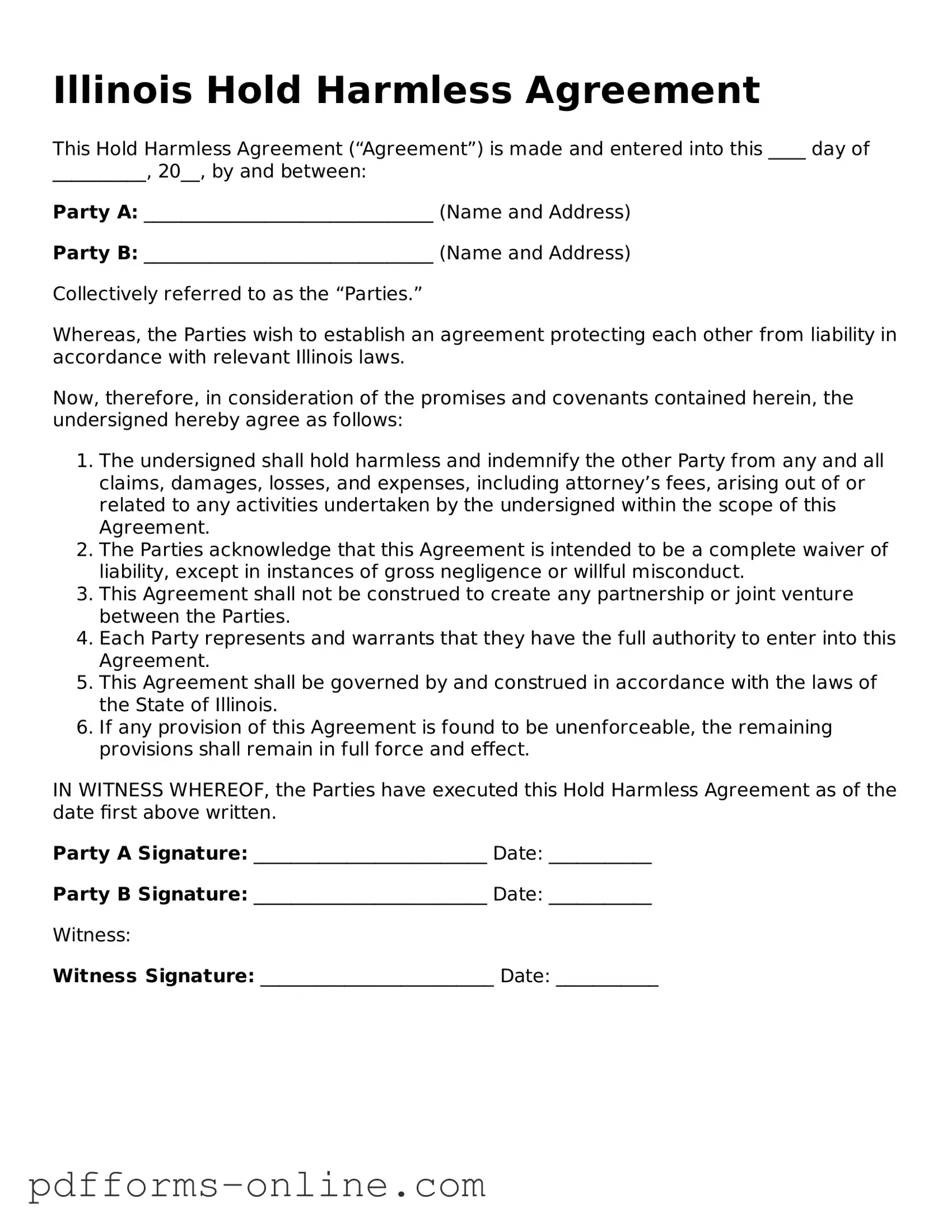The Illinois Hold Harmless Agreement is often compared to a waiver of liability. A waiver of liability is a document that individuals sign to relinquish their right to sue for injuries or damages that may occur during an activity. Like the Hold Harmless Agreement, it protects one party from legal responsibility for certain risks associated with an activity. Both documents emphasize the importance of informed consent, ensuring that individuals understand the potential dangers involved before participating.
Another similar document is the indemnity agreement. An indemnity agreement involves one party agreeing to compensate another for any losses or damages that arise from specific actions or events. This type of agreement shares similarities with the Hold Harmless Agreement in that both aim to protect one party from financial liability. However, while the Hold Harmless Agreement focuses on preventing legal claims, an indemnity agreement often involves compensation after the fact.
The release of liability form also bears resemblance to the Hold Harmless Agreement. This form is commonly used in recreational activities and events, allowing participants to acknowledge the risks involved and release the organizers from liability. Both documents require participants to accept responsibility for their own safety, thereby limiting the legal exposure of the organization or individual hosting the event.
Similarly, a consent form is related to the Hold Harmless Agreement. Consent forms are often used in medical settings, where patients agree to undergo procedures after being informed of the risks. Like the Hold Harmless Agreement, consent forms protect professionals from claims related to informed decisions made by individuals. Both documents require clear communication of potential risks to ensure that individuals can make educated choices.
Another document to consider is the liability insurance policy. While not a contract between two parties, a liability insurance policy serves a protective function similar to that of a Hold Harmless Agreement. It provides financial coverage for claims made against an individual or organization. Both documents aim to mitigate the financial risks associated with potential lawsuits, though the insurance policy offers a monetary safety net rather than a legal shield.
The participation agreement is also comparable to the Hold Harmless Agreement. This document is often used in sports or recreational activities, where participants agree to certain terms before engaging. Like the Hold Harmless Agreement, it typically includes a clause that limits liability for the organizers. Both documents require participants to acknowledge the inherent risks and agree to take responsibility for their involvement.
Another similar document is the safety acknowledgment form. This form is often used in workplaces or during training sessions, where individuals confirm their understanding of safety protocols and agree to follow them. The Hold Harmless Agreement and safety acknowledgment form both emphasize personal responsibility and the understanding of risks, aiming to reduce liability for the organization while promoting a safe environment.
The contractor agreement also shares similarities with the Hold Harmless Agreement. This document outlines the terms of work between a contractor and a client, often including clauses that limit liability for damages or injuries that may occur during the project. Both agreements serve to protect one party from legal repercussions, although the contractor agreement typically involves a broader scope of responsibilities and obligations.
Finally, the non-disclosure agreement (NDA) can be seen as related to the Hold Harmless Agreement in terms of protecting interests. An NDA is designed to keep sensitive information confidential and prevent its disclosure. While the primary focus of an NDA is on information security rather than liability, both documents create a framework that limits exposure to risks, whether those risks are legal or financial.
